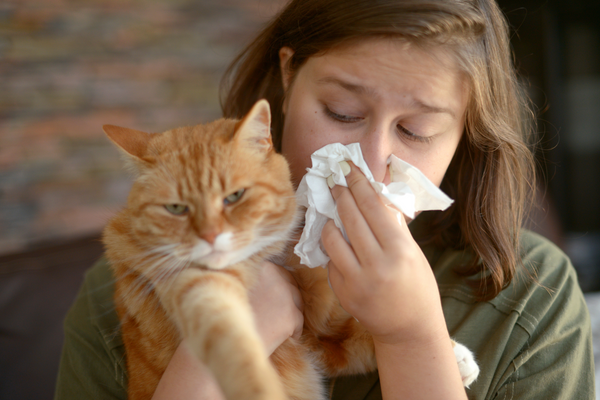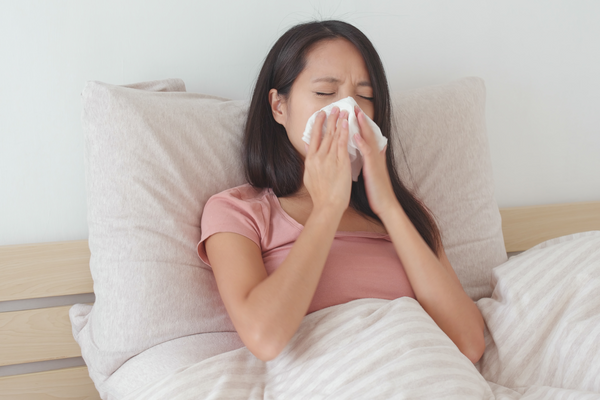The Surprising Chemicals Lurking in Common Household Dust

Most of us think of household dust as a minor annoyance – something that needs to be wiped away regularly to keep our allergies (and our nosy mother-in-laws) at bay. However, you may be surprised to learn that dust can be host to a number of toxic chemicals, as well as pollen, dead skin cells, pet dander, cockroaches, and other fine particles found in the local environment. Yikes!
Lately, indoor dust pollution is becoming a greater concern. And for good reason! No one wants to live in a home polluted with harmful chemicals and allergens. It’s where we spend most of our time, care for our families, and rest our heads. Americans typically spend 90% of their time indoors (and likely even more now while many of us are still sheltering-in-place during the COVID-19 pandemic) according to the U.S. Environmental Protection Agency (EPA).
The special dust mix in every home is based on the local climate, age and structure of the home, and the number of people and animals who live in it – as well as the occupants' habits and lifestyles. In most homes, dust consists of a blend of shed human skin, animal fur, decomposing insects (including cockroaches), tracked-in soil, soot, food residue and debris, lint and fibers (from clothes, upholstered furniture, bedding, carpets, and other fabrics), microscopic specks of plastic, lead, arsenic, even pesticides like DDT (which was banned in the U.S. in 1972).
In urban areas, household dust is often extra sooty from car exhaust and other sources of air pollution. Homes with furry and feathery companion animals contain more hair and pet dander: small pieces of hair, skin, or feathers that flake off animals. Generally, about 60% of common household dust comes from soil tracked inside on the bottoms of shoes or the paws of pets, or as airborne particles that have wafted through doors, windows, and other openings. The remaining 40% is a hodgepodge of substances that originate from inside the dwelling, including skin cells, pet fur, insect residue, carpet fibers, and kitchen grease.
Why We Should Care More About Dust
Much more than a minor nuisance, dust particles can cause major allergic, respiratory, and neurological reactions. They can also be a vehicle for the spread of airborne disease. You might be wondering how something so small and unassuming could wreak so much havoc. In a nutshell, dust is typically a complex cocktail of biological pollutants such as mold, mildew, bacteria, viruses, pollen, animal dander, cockroaches, and dust mites (microscopic animals living in household dust). And the list doesn’t end there.
Alarmingly, common indoor dust can also be clinging to heavy metals and harmful chemicals. Even worse, these harmful chemicals don’t just hang out in the dust: They can waltz right into our bodies when we breathe contaminated air or dust, touch contaminated dust, and accidentally get dust in our mouths from our hands. These chemicals pose a number of health hazards including cancer, hormone disruption, toxicity to the reproductive system, and more.
In 2015, researchers from George Washington University, the Silent Spring Institute, NRDC, Harvard University, and the University of California–San Francisco conducted the first study to comprehensively assess consumer product chemicals of concern in indoor dust across the U.S., to provide a picture of the toxic chemicals in the home, and to estimate potential exposures for children. They found that indoor dust not only contains the biological pollutants listed above, but also acts as a magnet to dangerous toxins – drawing them into its tiny particles and depositing it all over your home.
These substances can include:
- Heavy Metals
- Volatile Organic Compounds (VOCs)
- Semivolatile Organic Compounds (SVOCs)
- Phthalates (also known as “plasticizers”)
- Phenols, including Bisphenol A (BPA)
- Perfluorinated Chemicals (PFCs), including Polyfluoroalkyl Substances (PFASs)
- Flame retardants
- Fragrance chemicals
These harmful chemicals are entering our homes mainly through consumer products. BPA can come through food containers, paper receipts, and in plastic products. PFCs come from non-stick, grease-resistant chemicals used to coat waterproof fabrics, upholstery, carpeting, Teflon and other nonstick cookware, and food wrappers like popcorn bags and pizza boxes. Lead dust can come from older homes or older furniture. And alarmingly, these chemicals can linger inside for years, easily finding their ways into our bodies as we inhale or ingest them as dust.
Small children and pets are especially vulnerable to these toxins because they spend time on the floor, put things in their mouths, and have smaller body weight making them more sensitive to the effects of chemicals during key developmental stages of growth, according to the Environmental Working Group (EWG).
The Best Ways to Remove & Reduce Dust
This list of toxins hanging out in dust probably seems incredibly overwhelming, but take heart! By following best practices for dusting, you can easily remove and reduce them from your home.
- Dust regularly (at least once a week) with microfiber cloths. These are one of the best and most affordable cleaning tools that are available to remove dust! Their fibers do an incredible job of picking up and holding onto tiny particles that other cleaning methods would simply move around. They are super effective when used damp with a good cleaning product, such as Vital Oxide – our fragrance-free, dye-free, VOC-free, phthalate-free multi purpose cleaner and EPA-registered disinfectant. Bonus: Vital Oxide eliminates common allergens (including dust mite allergens) from your environment.
- Vacuum often using a vacuum fitted with a HEPA (High Efficiency Particulate Air) filter and change the filter regularly. HEPA is a type of filter that can trap a large number of very small particles that other vacuum cleaners would simply recirculate back into the air of your home.
- After dusting and vacuuming, banish dust mite allergens & pet dander with an Anti-Allergen Solution and a miticide.
- Buy more houseplants! According to a NASA study, it has been proven that houseplants can decrease dust levels by up to 20%. Dust-busting houseplants include rubber plants, ivy, date palm tree, and dripping guanyin.
- Don’t wear shoes inside the home and use a natural-fiber doormat. This will reduce the amount of dirt and soot being tracked into your home.
The bottom line: the very familiar practice of routine dusting – when done right – can actually transform your life and make your home a much cleaner, safer place to be.
Want more? Join The Ecology Works party on Instagram @ecologyworks for lots of helpful cleaning tips, healthy home advice, and environmental news. If you have any questions, please feel free to Contact Us or message us on Facebook. No question is too small! We’re here to help.



